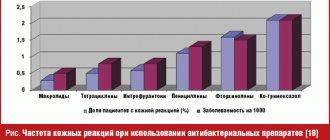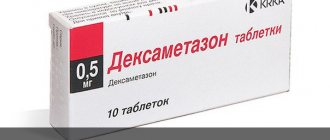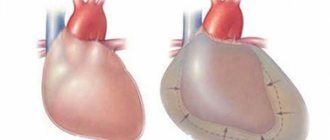The hormonal agent shows antiallergic, anti-inflammatory and immunosuppressive activity. Injections are prescribed for antitoxic, desensitizing, antishock therapy. Due to the active components, the susceptibility of adrenergic receptors to endogenous catecholamines increases.
What does Dexamethasone help with, indications and contraindications
The drug is a synthetic corticosteroid, an analogue of the hormone of the adrenal cortex. The component composition of the medication helps:
- normalize the functioning of extracellular structures of cartilage and bone tissues;
- reduce the level of capillary permeability;
- stabilize membranes;
- slow down the processes of cytokine release from lymphocytes and macrophages;
- accelerate protein catabolism;
- slow down glucose utilization and calcium absorption;
- retain water and sodium ions in tissues.
The processing of components occurs in the liver, partially in the kidneys and other organs. Metabolic products are excreted through the genitourinary system.
The drug is used against pathologies amenable to systemic therapy, as an addition to the main course of treatment. Intravenous and intramuscular injections are given when tablets or local medications are ineffective.
Dexamethasone is prescribed to patients:
- with allergies and rheumatic diseases;
- swelling of brain tissue;
- shock states of various origins;
- individual kidney lesions;
- autoimmune disorders;
- diseases of the respiratory tract, blood;
- acute severe dermatoses.
The drug is prescribed for hormone replacement therapy and the fight against inflammatory bowel pathologies. Dexamethasone is contraindicated:
- with hypersensitivity to the component composition;
- infectious, parasitic diseases of bacterial and viral origin;
- systemic mycoses, osteoporosis, immunodeficiency;
- myasthenia gravis, ulcers, colitis and other gastrointestinal diseases;
- lesions of the cardiovascular department;
- diabetes mellitus, psychosis, acute renal or liver failure.
The medicine is not injected into the joints if they are unstable, spontaneous bleeding of the apparatus, fractures or infectious lesions. The ban includes periarticular osteoporosis, the postoperative period - after arthroplasty.
How were the clinical trials conducted?
The RECOVERY study, which began in March 2021, involved more than 6.4 thousand patients with coronavirus infection. Of these, 2.1 thousand people were randomly selected and given 6 mg of dexamethasone per day for ten days. The remaining participants received the usual treatment in such cases.
The results showed that this immunosuppressant reduced the number of deaths among patients with severe forms of COVID-19: by a third among patients on ventilation and by 20% among those who needed supplemental oxygen.
Instructions for use for Dexamethasone injections
The medication is administered intravenously or intramuscularly; it is recommended for emergency conditions. In difficult cases, the dosage is increased from 4 to 20 mg, injections are repeated until the required therapeutic effect is obtained, the daily dose does not exceed 80 mg. After stabilization of the condition, treatment continues at 2-4 mg, with a gradual decrease in volumes until the medication is discontinued.
To create a long-lasting effect, injections are administered every 3-4 hours; the use of droppers with a solution is allowed. The treatment regimen depends on the indications:
- shock states - from 2 to 6 mg per kilogram of body weight, repeated after 2-6 hours, for 3 days;
- swelling of brain tissue - the first dose is 10 mg, later to suppress symptoms - 4 mg every 6 hours, for 1-2 days, on days 2-4 the dosage is reduced, the total time of therapy does not exceed 1 week;
- oncology - maintenance treatment 2 mg 2-3 times a day;
- allergies – 4-8 mg once a day.
The dose of the drug and its changes depend on health indicators and relief of clinical signs of acute phases of pathologies.
Why should dexamethasone be taken with caution?
“[Side effects] are the same as other drugs in this group - increased susceptibility to thrombosis, increased blood pressure, increased blood glucose levels, the ability to cause stomach ulcers, and so on. This is a serious drug, for serious situations with serious side effects. Therefore, only an experienced doctor will understand what’s what,” said Kagan.
The doctor explained that the drug, according to preliminary results of the study, does not affect the virus itself, it only reduces the excessive inflammation that occurs in the body after infection.
Kagan did not recommend using this drug as a preventive measure or in the first week after coronavirus infection, as it suppresses the immune system. “This can only help the virus,” the doctor explained.
In general, as Kagan explained, dexamethasone has been known to mankind since the 1960s and has long been registered for the treatment of autoimmune diseases in all countries, including the USSR and Russia. Traditional therapy for many autoimmune diseases, such as systemic lupus erythematosus, glomerulonephritis, bronchial asthma, Kawasaki syndrome, autoimmune thrombocytopenic purpura and others, is based on corticosteroids.
It is logical to use corticosteroids for coronavirus infection, the doctor noted, but there were no clear recommendations, since there was no previous evidence of the effectiveness of this drug against COVID-19. In addition, doctors are aware of the risks of using such steroids. At the same time, in the seventh version of the temporary guidelines of the Ministry of Health “Prevention, diagnosis and treatment of new coronavirus infection” dated June 3, there was a recommendation that this drug can be used in severe cases of the disease, Kagan noted.
“It should be noted that in the UK the dose of dexamethasone was used significantly lower than that recommended by our Ministry of Health - 6 mg per day (in domestic recommendations - 20 mg per day. I think that the British managed to find the optimal dose, which already provides a positive effect and minimizes side effects “, concluded the doctor.
Dexamethasone tablets 0.5 mg No. 10
Compound
Active substance: dexamethasone 500 mcg. Excipients: lactose monohydrate, pregelatinized starch, colloidal silicon dioxide, magnesium stearate.
Pharmacokinetics
Dexamethasone is rapidly and almost completely absorbed after oral administration. The bioavailability of dexamethasone tablets is approximately 80%. Cmax in blood plasma and the maximum effect after oral administration are achieved within 1-2 hours; After taking a single dose, the effect lasts for approximately 2.75 days.
In blood plasma, approximately 77% of dexamethasone is bound to proteins, mainly albumin. A small amount of dexamethasone binds to non-albumin proteins. Dexamethasone is a fat-soluble substance that can penetrate into extra- and intracellular spaces. In the central nervous system (hypothalamus, pituitary gland), its effects are due to binding to membrane receptors. In peripheral tissues it binds to cytoplasmic receptors. Its disintegration occurs at the place of its action, i.e. in a cage. Metabolized primarily in the liver to the formation of inactive metabolites. Excreted by the kidneys.
Indications for use
- From the endocrine system: replacement therapy for primary and secondary (pituitary) adrenal insufficiency, congenital adrenal hyperplasia, subacute thyroiditis and severe forms of post-radiation thyroiditis.
- Rheumatic diseases: rheumatoid arthritis (including juvenile chronic arthritis) and extra-articular lesions of rheumatoid arthritis (lungs, heart, eyes, cutaneous vasculitis).
- Systemic connective tissue diseases, vasculitis and amyloidosis (as part of combination therapy): systemic lupus erythematosus (treatment of polyserositis and lesions of internal organs), Sjogren's syndrome (treatment of lesions of the lungs, kidneys and brain), systemic sclerosis (treatment of myositis, pericarditis and alveolitis) , polymyositis, dermatomyositis, systemic vasculitis, amyloidosis (replacement therapy for adrenal insufficiency), scleroderma.
- Skin diseases: pemphigoid, bullous dermatitis, dermatitis herpetiformis, exfoliative dermatitis, exudative erythema (severe forms), erythema nodosum, seborrheic dermatitis (severe forms), psoriasis (severe forms), lichen, fungoid mycoses, Quincke's edema, bronchial asthma, contact dermatitis , atopic dermatitis, serum sickness, allergic rhinitis, drug disease (hypersensitivity to drugs), urticaria after blood transfusion, systemic immune diseases (sarcoidosis, temporal arteritis).
- Eye diseases: proliferative changes in the orbit (endocrine ophthalmopathy, pseudotumors), sympathetic ophthalmia, immunosuppressive therapy for corneal transplantation.
- Gastrointestinal diseases: ulcerative colitis (severe exacerbations), Crohn's disease (severe exacerbations), chronic autoimmune hepatitis, rejection after liver transplantation.
- Blood diseases: congenital or acquired acute pure aplastic anemia, autoimmune hemolytic anemia, secondary thrombocytopenia in adults, erythroblastopenia, acute lymphoblastic leukemia (induction therapy), myelodysplastic syndrome, angioimmunoblastic malignant T-cell lymphoma (in combination with cytostatics), plastocytoma (in combination with cytostatics), anemia after myelofibrosis with myeloid metaplasia or lymphoplasmacytoid immunocytoma, systemic histiocytosis (systemic process).
- Kidney diseases: primary and secondary glomerulonephritis (Goodpasture syndrome), kidney damage in systemic connective tissue diseases (systemic lupus erythematosus, Sjogren's syndrome), systemic vasculitis (usually in combination with cyclophosphamide), glomerulonephritis in polyarteritis nodosa, Churg-Strauss syndrome, Wegener's granulomatosis Henoch-Schönlein purpura, mixed cryoglobulinemia, kidney damage in Takayasu arteritis, interstitial nephritis, immunosuppressive therapy after kidney transplantation, inducing diuresis or reducing proteinemia in idiopathic nephrotic syndrome (without uremia) and in kidney damage due to systemic lupus erythematosus.
- Malignant diseases: palliative therapy of leukemia and lymphoma in adults, acute leukemia in children, hypercalcemia in malignant neoplasms.
- Other indications: tuberculous meningitis with subarachnoid blockade (in combination with adequate anti-tuberculosis therapy), trichinosis with neurological or myocardial manifestations.
Contraindications
For short-term use for “life-saving” indications, the only contraindication is hypersensitivity to the active substance or auxiliary components of the drug.
The drug Dexamethasone-KRKA is contraindicated in patients with galactosemia, lactase deficiency and glucose-galactose malabsorption syndrome, due to the fact that the drug contains lactose.
Carefully. Parasitic and infectious diseases of a viral, fungal or bacterial nature (currently or recently suffered, including recent contact with a patient) - herpes simplex, herpes zoster (viremic phase), chicken pox, measles; amebiasis, strongyloidiasis (established or suspected); systemic mycosis; active and latent tuberculosis, pre- and post-vaccination period (8 weeks before and 2 weeks after vaccination), lymphadenitis after BCG vaccination, immunodeficiency conditions (including AIDS or HIV infection).
Diseases of the gastrointestinal tract: peptic ulcer of the stomach and duodenum, esophagitis, gastritis, acute or latent peptic ulcer, recently created intestinal anastomosis, ulcerative colitis with the threat of perforation or abscess formation, diverticulitis.
Diseases of the cardiovascular system, incl. recent myocardial infarction (in patients with acute and subacute myocardial infarction, the necrosis focus may spread, the formation of scar tissue may slow down and, as a result, the heart muscle will rupture), decompensated chronic heart failure, arterial hypertension, hyperlipidemia.
Endocrine diseases: diabetes mellitus (including impaired carbohydrate tolerance), thyrotoxicosis, hypothyroidism, Itsenko-Cushing's disease.
Severe chronic renal and/or liver failure, nephrourolithiasis; hypoalbuminemia and conditions predisposing to its occurrence; systemic osteoporosis, myasthenia gravis, acute psychosis, obesity (III-IV stage), poliomyelitis (except for the form of bulbar encephalitis), open-angle and closed-angle glaucoma, lactation period.
Directions for use and doses
Doses are set individually for each patient, depending on the nature of the disease, the expected duration of treatment, tolerability of the drug and the patient's response to the therapy.
The recommended starting dose for adults is 0.5 mg to 9 mg/day.
The usual maintenance dose is from 0.5 mg to 3 mg/day.
The minimum effective daily dose is 0.5-1 mg.
The maximum daily dose is 10-15 mg.
The daily dose can be divided into 2-4 doses.
After achieving a therapeutic effect, the dose is gradually reduced (usually by 0.5 mg every 3 days until a maintenance dose is reached).
With long-term use of high doses orally, the drug is recommended to be taken with meals, and antacids should be taken between meals. The duration of dexamethasone use depends on the nature of the pathological process and the effectiveness of treatment and ranges from several days to several months or more. Treatment is stopped gradually (at the end several injections of corticotropin are prescribed).
- for bronchial asthma, rheumatoid arthritis, ulcerative colitis - 1.5-3 mg/day;
- for systemic lupus erythematosus - 2-4.5 mg/day;
- for oncohematological diseases - 7.5-10 mg.
For the treatment of acute allergic diseases, it is advisable to combine parenteral and oral administration: 1 day - 4-8 mg parenterally; Day 2 - orally, 4 mg 3 times a day; 3, 4 days - orally, 4 mg 2 times a day; 5, 6 days - 4 mg/day, orally; Day 7 - drug withdrawal.
Dosing in children
Children (depending on age) are prescribed 2.5-10 mg/m2 body surface area/day, dividing the daily dose into 3-4 doses.
Diagnostic tests for hyperfunction of the adrenal cortex
Short 1-mg dexamethasone test: 1 mg dexamethasone orally at 11.00; blood sampling to determine serum cortisol at 8:00 am the next day.
Special 2-day test with 2 mg dexamethasone: 2 mg dexamethasone orally every 6 hours for 2 days; 24-hour urine is collected to determine the concentration of 17-hydroxycorticosteroids.
Storage conditions
Store the drug at a temperature not exceeding 25°C, in its original packaging. Keep out of the reach of children.
Best before date
5 years. Do not use the drug after the expiration date.
special instructions
In patients requiring long-term therapy with dexamethasone, after cessation of therapy, withdrawal syndrome may develop (also without clear signs of adrenal insufficiency): fever, nasal discharge, conjunctival hyperemia, headache, dizziness, drowsiness and irritability, muscle and joint pain , vomiting, weight loss, weakness, convulsions. Therefore, dexamethasone must be discontinued by gradually reducing the dose. Rapid withdrawal of the drug can be fatal.
In patients who have received long-term therapy with dexamethasone and are exposed to stress after its discontinuation, dexamethasone use should be resumed, due to the fact that induced adrenal insufficiency may persist for several months after discontinuation of the drug.
Dexamethasone therapy may mask signs of existing or new infections and signs of intestinal perforation in patients with ulcerative colitis. Dexamethasone may aggravate the course of systemic fungal infections, latent amoebiasis or pulmonary tuberculosis.
In patients with acute pulmonary tuberculosis, dexamethasone can be prescribed (together with anti-tuberculosis drugs) only in cases of fulminant or severe disseminated disease. Patients with inactive pulmonary tuberculosis receiving dexamethasone therapy or patients with positive tuberculin tests should simultaneously receive anti-tuberculosis chemoprophylaxis.
Particular attention and careful medical supervision is necessary for patients with osteoporosis, hypertension, heart failure, tuberculosis, glaucoma, liver or kidney failure, diabetes mellitus, active peptic ulcers, fresh intestinal anastomoses, ulcerative colitis and epilepsy. The drug is prescribed with caution in the first weeks after acute myocardial infarction, in patients with thromboembolism, myasthenia gravis, glaucoma, hypothyroidism, psychosis or psychoneurosis, as well as in patients over 65 years of age.
During dexamethasone therapy, decompensation of diabetes mellitus or transition from latent to clinically manifest diabetes mellitus is possible.
With long-term treatment, monitoring of serum potassium levels is necessary.
Live vaccinations are contraindicated during dexamethasone therapy.
Immunization with killed viral or bacterial vaccines does not give the expected increase in the titer of specific antibodies and therefore does not have the necessary protective effect. Dexamethasone-KRKA is not usually prescribed for 8 weeks before vaccination and for 2 weeks after vaccination.
Patients taking high doses of dexamethasone for a long time should avoid contact with people with measles; If accidental contact occurs, prophylactic treatment with immunoglobulin is recommended.
Caution should be used when treating patients who have recently undergone surgery or a bone fracture because dexamethasone may delay the healing of wounds and fractures.
The effect of glucocorticosteroids is enhanced in patients with liver cirrhosis or hypothyroidism.
Dexamethasone-KRKA is used in children and adolescents only according to strict indications. During treatment, strict monitoring of the growth and development of the child or adolescent is necessary.
Special information about some components of the drug
The drug Dexamethasone-KRKA contains lactose, and therefore its use in patients with galactosemia, lactase deficiency and glucose-galactose malabsorption syndrome is contraindicated.
Description
Glucocorticosteroid.
Use in children
Dexamethasone is used in children and adolescents only under strict indications. During treatment, strict monitoring of the growth and development of the child or adolescent is necessary.
Pharmacodynamics
Glucocorticosteroid (GCS) is a methylated derivative of fluoroprednisolone, inhibits the release of interleukin-1 and interleukin-2, interferon gamma from lymphocytes and macrophages. It has anti-inflammatory, antiallergic, desensitizing, antishock, antitoxic and immunosuppressive effects.
Suppresses the release of adrenocorticotropic hormone (ACTH) and beta-lipotropin by the pituitary gland, but does not reduce the content of circulating beta-endorphin. Inhibits the secretion of thyroid-stimulating hormone (TSH) and follicle-stimulating hormone (FSH).
Increases the excitability of the central nervous system (CNS), reduces the number of lymphocytes and eosinophils, increases the number of red blood cells (stimulates the production of erythropoietins).
Interacts with specific cytoplasmic receptors, forms a complex that penetrates the cell nucleus, stimulates the synthesis of mRNA, which induces the formation of proteins, incl. lipocortin, which mediate cellular effects. Lipocortin inhibits phospholipase A2, suppresses the release of arachidonic acid and suppresses the synthesis of endoperoxides, Pg, leukotrienes, which contribute to inflammation, allergies, etc.
- Protein metabolism: reduces the amount of protein in plasma (due to globulins) with an increase in the albumin/globulin ratio, increases the synthesis of albumins in the liver and kidneys; enhances protein catabolism in muscle tissue.
- Lipid metabolism: increases the synthesis of higher fatty acids and triglycerides (TG), redistributes fat (fat accumulation mainly in the shoulder girdle, face, abdomen), leads to the development of hypercholesterolemia.
- Carbohydrate metabolism: increases the absorption of carbohydrates from the gastrointestinal tract (GIT); increases the activity of glucose-6-phosphatase, leading to an increase in the flow of glucose from the liver into the blood; increases the activity of phosphoenolpyruvate carboxylase and the synthesis of aminotransferases, leading to the activation of gluconeogenesis.
Water-electrolyte metabolism: retains Na+ and water in the body, stimulates the excretion of K+ (MCS activity), reduces the absorption of Ca2+ from the gastrointestinal tract, “washes out” Ca2+ from the bones, increases the excretion of Ca2+ by the kidneys.
The anti-inflammatory effect is associated with inhibition of the release of inflammatory mediators by eosinophils; inducing the formation of lipocortin and reducing the number of mast cells that produce hyaluronic acid; with a decrease in capillary permeability; stabilization of cell membranes and organelle membranes (especially lysosomal ones).
The antiallergic effect develops as a result of suppression of the synthesis and secretion of allergy mediators, inhibition of the release of histamine and other biologically active substances from sensitized mast cells and basophils, a decrease in the number of circulating basophils, suppression of the development of lymphoid and connective tissue, a decrease in the number of T- and B-lymphocytes, mast cells, reducing the sensitivity of effector cells to allergy mediators, inhibiting antibody formation, changing the body's immune response.
In chronic obstructive pulmonary disease (COPD), the action is based mainly on inhibition of inflammatory processes, inhibition of development or prevention of swelling of the mucous membranes, inhibition of eosinophilic infiltration of the submucosal layer of the bronchial epithelium, deposition of circulating immune complexes in the bronchial mucosa, as well as inhibition of erosion and desquamation of the mucous membrane . Increases the sensitivity of beta-adrenergic receptors of small and medium-caliber bronchi to endogenous catecholamines and exogenous sympathomimetics, reduces the viscosity of mucus by inhibiting or reducing its production.
Antishock and antitoxic effects are associated with an increase in blood pressure (due to an increase in the concentration of circulating catecholamines and restoration of the sensitivity of adrenergic receptors to them, as well as vasoconstriction), a decrease in the permeability of the vascular wall, membrane protective properties, and activation of liver enzymes involved in the metabolism of endo- and xenobiotics.
The immunosuppressive effect is due to inhibition of the release of cytokines (interleukin1, interleukin2; interferon gamma) from lymphocytes and macrophages.
Suppresses the synthesis and secretion of ACTH, and secondarily the synthesis of endogenous corticosteroids. Inhibits connective tissue reactions during the inflammatory process and reduces the possibility of scar tissue formation.
The peculiarity of the action is significant inhibition of pituitary function and the almost complete absence of MCS activity. Doses of 1-1.5 mg/day inhibit the adrenal cortex; biological T1/2 - 32-72 hours (duration of inhibition of the hypothalamus-pituitary-adrenal cortex system).
In terms of the strength of glucocorticosteroid activity, 0.5 mg of dexamethasone corresponds to approximately 3.5 mg of prednisone (or prednisolone), 15 mg of hydrocortisone or 17.5 mg of cortisone.
Side effects
Classification of the incidence of side effects (WHO): very often >1/10, often from >1/100 to <1/10, infrequently from >1/1000 to <1/100, rarely from >1/10000 to <1/ 1000, very rarely from < 1/10000, including isolated reports.
From the immune system: uncommon - hypersensitivity reactions, decreased immune response and increased susceptibility to infections.
From the endocrine system: often - transient adrenal insufficiency, growth retardation in children and adolescents, adrenal insufficiency and atrophy (decreased response to stress), Itsenko-Cushing syndrome, menstrual irregularities, hirsuitism, transition of latent diabetes mellitus to clinically manifest, increased requirements for insulin or oral hypoglycemic drugs in patients with diabetes mellitus, sodium and water retention, increased potassium loss; very rarely - hypokalemic alkalosis, negative nitrogen balance due to protein catabolism.
Metabolic and nutritional disorders: often - decreased tolerance to carbohydrates, increased appetite and weight gain, obesity; infrequently - hypertriglyceridemia.
From the nervous system: often - mental disorders; infrequently - swelling of the optic nerve papillae and increased intracranial pressure (pseudotumor cerebri) after discontinuation of therapy, dizziness, headache; very rarely - convulsions, euphoria, insomnia, irritability, hyperkinesia, depression; rarely - psychosis.
From the digestive system: infrequently - peptic ulcers, acute pancreatitis, nausea, hiccups, stomach or duodenal ulcers; very rarely - esophagitis, ulcer perforation and bleeding of the gastrointestinal tract (hematomesis, melena), pancreatitis, perforation of the gallbladder and intestines (especially in patients with chronic inflammatory diseases of the large intestine).
From the senses: infrequently - posterior subcapsular cataract, increased intraocular pressure, tendency to develop secondary bacterial, fungal or viral eye infections, trophic changes in the cornea, exophthalmos.
From the cardiovascular system: infrequently - arterial hypertension, hypertensive encephalopathy; very rarely - polyfocal ventricular extrasystoles, transient bradycardia, heart failure, myocardial rupture after a recent acute infarction.
From the skin: often - erythema, thinning and fragility of the skin, delayed wound healing, striae, petechiae and ecchymosis, increased sweating, steroid acne, suppressed skin reaction during allergy tests; very rarely - angioedema, allergic dermatitis, urticaria.
From the musculoskeletal system: often - muscle atrophy, osteoporosis, muscle weakness, steroid myopathy (muscle weakness due to catabolism of muscle tissue); infrequently - aseptic necrosis of bones; very rarely - vertebral compression fractures, tendon ruptures (especially with the combined use of certain quinolones), damage to articular cartilage and bone necrosis (associated with frequent intra-articular injections).
From the hematopoietic system: rarely - thromboembolic complications, a decrease in the number of monocytes and/or lymphocytes, leukocytosis, eosinophilia (as with other glucocorticosteroids), thrombocytopenia and non-thrombocytopenic purpura.
Allergic reactions: rarely - skin rash, itching, angioedema, bronchospasm, anaphylactic shock.
From the genitourinary system: rarely - impotence.
Signs and symptoms of corticosteroid withdrawal syndrome
If a patient taking glucocorticosteroids for a long time quickly reduces the dose of the drug, signs of adrenal insufficiency, arterial hypotension, and death may develop.
In some cases, withdrawal symptoms may be similar to symptoms and signs of exacerbation or relapse of the disease for which the patient is being treated. If severe adverse events develop, treatment with Dexamethasone-KRKA should be discontinued.
Use during pregnancy and breastfeeding
During pregnancy (especially in the first trimester), Dexamethasone-KRKA can be used only when the expected therapeutic effect outweighs the potential risk to the fetus. With long-term therapy with dexamethasone during pregnancy, the possibility of impaired fetal growth cannot be excluded. If the drug Dexamethasone-KRKA is used in the last trimester of pregnancy, there is a risk of atrophy of the adrenal cortex in the fetus, which may require replacement therapy in the newborn.
If a woman received glucocorticosteroids during pregnancy, additional use of glucocorticosteroids is recommended during childbirth. If labor is prolonged or a cesarean section is planned, it is recommended to administer 100 mg of hydrocortisone intravenously every 8 hours during the peripartum period.
If therapy with Dexamethasone-KRKA is necessary, breastfeeding should be discontinued.
Interaction
The simultaneous use of dexamethasone and nonsteroidal anti-inflammatory drugs (NSAIDs) increases the risk of developing and forming ulcers of the gastrointestinal tract.
The effect of dexamethasone is reduced with simultaneous use of inducers of the CYP3A4 isoenzyme (for example, phenytoin, phenobarbitone, carbamazepine, primidone, rifabutin, rifampicin) or drugs that increase the metabolic clearance of glucocorticoids (ephedrine and aminoglutethimide); in such cases, it is necessary to increase the dose of dexamethasone.
Interactions between dexamethasone and the above drugs may distort the results of dexamethasone suppression tests. If dexamethasone testing must be performed during therapy with one of these drugs, this interaction should be taken into account when interpreting test results.
The simultaneous use of dexamethasone and inhibitors of the CYP3A4 isoenzyme (for example, ketoconazole, macrolide antibiotics) may lead to an increase in the concentration of dexamethasone in the blood.
Concomitant use of drugs that are metabolized by CYP3A4 (for example, indinavir, erythromycin) may increase their clearance, which may be accompanied by a decrease in their serum concentrations.
Dexamethasone reduces the effectiveness of hypoglycemic drugs, antihypertensive drugs, praziquantel and natriuretics (the dose of these drugs must be increased); increases the activity of heparin, albendazole and potassium-sparing diuretics (if necessary, reduce the dose of these drugs).
Dexamethasone may alter the effect of coumarin anticoagulants, so more frequent monitoring of prothrombin time is recommended during therapy. Antacids reduce the absorption of dexamethasone in the stomach. Smoking does not affect the pharmacokinetics of dexamethasone.
With simultaneous use of oral contraceptives, T1/2 of glucocorticosteroids may increase, with a corresponding increase in their biological effects and an increase in the frequency of adverse side effects.
The simultaneous use of ritodrine and dexamethasone during labor is contraindicated, as this can lead to maternal death due to pulmonary edema. Concomitant use of dexamethasone and thalidomide may cause toxic epidermal necrolysis.
Potential therapeutically beneficial interactions: Concomitant use of dexamethasone and metoclopramide, diphenhydramine, prochlorperazine, or 5-HT3 receptor antagonists (serotonin or 5-hydroxytryptamine receptor type 3), such as ondansetron or granisetron, is effective in the prevention of nausea and vomiting caused by chemotherapy (cisplatin, cyclophosphamide, methotrexate, fluorouracil).
Overdose
Single use of a large number of tablets does not lead to clinically significant intoxication.
Symptoms: increased dose-dependent side effects are possible. In this case, the dose of the drug should be reduced.
Treatment: supportive and symptomatic.
There is no specific antidote.
Hemodialysis is ineffective.
Impact on the ability to drive vehicles and operate machinery
Considering the possible side effects during therapy with Dexamethasone-KRKA, care must be taken when driving vehicles, operating machinery, or engaging in other activities that require increased concentration and speed of psychomotor reactions.
Dexamethasone
Dexamethasone is a synthetic hormone of the adrenal cortex with glucocorticosteroid action (GCS). It has anti-inflammatory and immunosuppressive effects, and also affects energy metabolism, glucose homeostasis and (via negative feedback) the secretion of hypothalamic activating factor and pituitary adrenocorticotropic hormone.
GCS are fat-soluble substances and therefore easily penetrate into target cells through cell membranes. The binding of a hormone to a receptor causes conformational changes in the receptor and increases its affinity for DNA. The hormone-receptor complex enters the cell nucleus and binds to the regulatory region of the DNA molecule, also known as the glucocorticoid response element (GRE).
The activated receptor binds to GREs or specific genes and regulates messenger RNA (mRNA) transcription. The newly formed mRNA is transported to ribosomes, which then participate in the formation of new proteins. Depending on the type of target cells and cellular processes, the formation of new proteins can be either enhanced (for example, the synthesis of tyrosine transaminase in liver cells) or suppressed (for example, the synthesis of IL-2 in lymphocytes). Since receptors for GCS are found in all tissues, their action is realized in most cells of the body.
Effect on energy metabolism and glucose homeostasis:
Dexamethasone, along with insulin, glucagon and catecholamines, regulates the accumulation and expenditure of energy. In the liver, it stimulates the formation of glucose from pyruvate and amino acids and the formation of glycogen. In peripheral tissues, particularly in muscles, it reduces glucose consumption and mobilizes amino acids (from proteins), which are a substrate for gluconeogenesis in the liver. Direct effects on fat metabolism include central redistribution of adipose tissue and increased lipolysis in response to catecholamines.
Through receptors in the proximal tubules of the kidneys, dexamethasone stimulates renal blood flow and glomerular filtration, inhibits the formation and secretion of vasopressin and improves the ability of the kidneys to excrete acids.
Increases the sensitivity of blood vessels to pressor agents.
In high doses, dexamethasone suppresses the formation of collagen types I and III by fibroblasts and the formation of glycosaminoglycans; by inhibiting the formation of extracellular collagen and matrix, they slow down wound healing. Long-term use of high doses causes progressive bone tissue resorption as an indirect effect, and directly reduces its formation (stimulates the secretion of parathyroid hormone and suppresses the secretion of calcitonin). In addition, it leads to a negative calcium balance, reduces calcium absorption in the intestines and increases its excretion by the kidneys. This usually results in secondary hyperparathyroidism and phosphaturia.
Action on the hypothalamus and pituitary gland:
Dexamethasone has a 30 times more pronounced effect than endogenous cortisol. Therefore, it is a more potent inhibitor of the secretion of corticotropin-releasing factor (CRF) and adrenocorticotropic hormone (ACTH). In pharmacological doses, it inhibits the hypothalamic-pituitary-adrenal system and promotes the development of secondary adrenal insufficiency.
Adrenal insufficiency can develop as early as 5-7 days of dexamethasone administration in daily doses equivalent to 20-30 mg of prednisone or after 30 days of low-dose therapy. After discontinuation of a short course of therapy (up to 5 days) with high doses, the function of the adrenal cortex can be restored within one week; after a long course, normalization occurs later; this process usually takes up to 1 year. Some patients may develop irreversible atrophy of the adrenal cortex.
Anti-inflammatory and immunosuppressive effects
glucocorticosteroids is associated with their molecular and biochemical effects. The molecular anti-inflammatory effect is the result of the interaction of glucocorticosteroids with glucocorticoid receptors and changes in the expression of a number of genes that regulate the formation of many information molecules, proteins and enzymes involved in the process of inflammation. This leads to a decrease or prevention of the tissue response to inflammation: inhibition of the accumulation of macrophages and leukocytes, suppression of phagocytosis and release of lysosomal enzymes, synthesis of inflammatory mediators, blocking of the macrophage inhibitory factor.
Dexamethasone reduces the expansion and permeability of capillaries, reduces the adhesion of leukocytes to the endothelium, and inhibits the synthesis of Pg, leukotrienes, and thromboxanes.
Dexamethasone reduces the formation of leukotrienes by reducing the release of arachidonic acid from cellular phospholipids, which results from inhibition of phospholipase A2 activity. The effect on phospholipase is mediated by an increase in the concentration of lipocortin (macrocortin), which is an inhibitor of phospholipase A2. The suppressive effect of dexamethasone on the synthesis of prostaglandins and thromboxane is the result of a decrease in the synthesis of specific mDNA encoding the formation of cyclooxygenase.
Dexamethasone prevents or inhibits cellular immune reactions (delayed hypersensitivity reactions), reduces the number of T-lymphocytes (T-helper type I), monocytes and eosinophils, the binding of immunoglobulins to their receptors, inhibits the synthesis of interleukins: reduces T-lymphocytic blastogenesis and reduces primary immune answer. Activates humoral immunity by stimulating T-helper type II - enhances the production of antibodies. A significant effect is a decrease in the formation of tumor necrosis factor (TNF) and IL-1.
special instructions
Check with your doctor before using Dexamethasone if:
- you have malignant neoplasms of the hematopoietic organs, as the risk of developing a very rare, potentially life-threatening condition caused by the sudden destruction of tumor cells increases,
- you have problems with your kidneys or liver,
- you have high blood pressure or heart disease,
- you have diabetes mellitus or a family history of it,
- for osteoporosis, especially in women during menopause,
- muscle weakness has been observed in the past with the use of this or other corticosteroids,
- you have increased intraocular pressure (glaucoma) or have a family history of glaucoma,
- you have a stomach ulcer (peptic ulcer),
- you have a mental disorder or have a mental illness that can be complicated by the use of corticosteroids, such as “steroid psychosis”,
- you have epilepsy,
- you have a migraine,
- you have an infestation caused by parasites,
- you have tuberculosis,
- you have growth retardation,
- Do you have Cushing's syndrome?
- you have had a head injury,
- You have suffered a stroke.
If you are in any doubt if any of the above applies to you, talk to your doctor or pharmacist before using Dexamethasone.
Important information when using this type of medicine
If you develop an infection while taking this drug, you should call your doctor. Please tell the doctor, dentist or specialist treating you that you are currently taking or have recently taken corticosteroids.
Do not use Dexamethasone to treat acute respiratory distress syndrome (ARDS, a serious lung disease) if you were diagnosed with this condition more than 2 weeks ago.
Dexamethasone and viral infections
While taking this drug, you should avoid contact with people who have chickenpox, shingles, or measles, especially if you have never had these diseases, because specialized treatment will be needed if you get it or if you think you are at risk of developing any of these diseases. of these diseases, you should consult a doctor immediately. You should also tell your doctor if you have ever had measles or chickenpox and if you have been vaccinated against these diseases in the past. Please consult a doctor or specialist who is treating you in a hospital if:
- Did you have an accident,
- You are sick
- you are planning a surgical intervention, including oral surgery,
- You require vaccination.
If any of the above applies to you, contact your doctor or healthcare professional, even if you have stopped taking the drug.
If the drug is used in childhood, it is important that the doctor regularly monitor the child's growth and development. Dexamethasone should not be given empirically to premature infants with respiratory disease.
Special instructions and precautions
Consult your doctor if you experience:
Symptoms of neoplasm lysis syndrome such as muscle spasms, muscle weakness, restlessness, loss or blurred vision, and shortness of breath if a hematopoietic neoplasm is present.
Other medicines and Dexamethasone
- Tell your doctor if you are taking, have recently taken, or should take any other medications.
- Some drugs may increase the effect of Dexamethasone and your doctor should monitor you if you take these drugs (including some drugs used to treat HIV: ritonavir, cobicistat).
Other drugs and Dexamethasone may interact with each other.
Especially:
- Medicines to treat heart and circulatory diseases, such as warfarin, blood pressure medications and diuretics.
- Antibiotics such as rifampicin and rifabutin.
- Drugs to treat epilepsy such as phenytoin, carbamazepine, phenobarbitone and primidone.
- Painkillers or anti-inflammatory drugs such as aspirin or phenylbutazone.
- Drugs for the treatment of diabetes mellitus.
- Drugs that cause a decrease in potassium levels in the blood.
- Drugs that are used to treat myasthenia gravis.
- Antineoplastic drugs such as aminoglutethimide.
- Ephedrine (used to relieve nasal congestion symptoms).
- Acetazolamide, used for glaucoma.
- Carbenoxolone is sometimes used to treat stomach ulcers.
Important information about the drug
- Dexamethasone is a corticosteroid drug that is used to treat a variety of conditions, including serious illnesses.
- It must be used regularly to obtain maximum effect.
- You should not stop taking the drug without consulting a doctor. It is necessary to reduce the dose gradually.
- Dexamethasone may cause side effects in some people; some problems such as mood changes (depression or euphoria) or stomach problems can develop quite quickly. If you feel unwell, do not stop taking the drug, but consult a doctor immediately.
- Some side effects only develop after several weeks or months of use. These include weakness in the arms and knees or a rounding of the face (moon face).
- You should avoid people who have chickenpox or shingles, especially if you have never had these diseases. This is a big risk for you. If you have been in contact with someone who has chickenpox or shingles, contact your doctor immediately.










